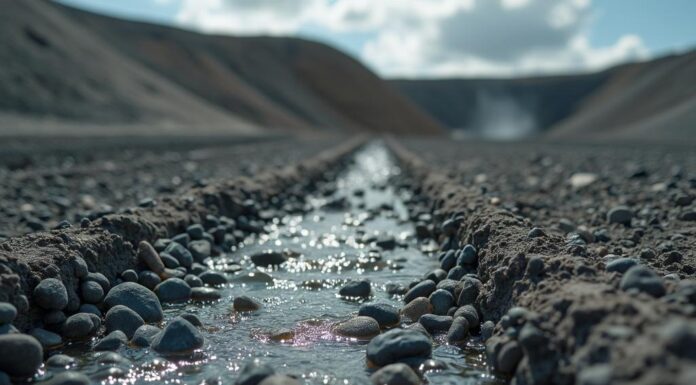Introduction
As the world races towards a cleaner, electrified future, the demand for lithium, crucial for electric vehicle (EV) batteries, has surged. However, this rush for “white gold” comes with significant environmental and social costs. This article delves into these often overlooked consequences, exploring expert opinions, recent research findings, and sustainable alternatives.
The Environmental Footprint of Lithium Mining
The global thirst for lithium is predominantly quenched by four countries — Australia, Chile, Argentina, and China — which collectively produced 170.8 thousand tonnes in 2023. While lithium powers clean technologies like electric vehicles (EVs), its extraction paints a troubling ecological picture:
- Water Usage: In arid regions like Chile’s Atacama Desert, lithium mining consumes vast amounts of water. The process not only exacerbates local drought conditions but also threatens ecosystems and local communities’ water supply.
- Carbon Emissions: It’s estimated that every tonne of lithium mined results in around 15 tonnes of CO2 emissions. When compared to other metals like cobalt, the carbon footprint is considerable but still dwarfed by the colossal emissions from fossil fuels.
- Biodiversity Loss: A startling example includes two flamingo species in Chile facing threats due to habitat damage from mining activities.
Emerging technologies such as Direct Lithium Extraction (DLE) offer some hope by potentially reducing water usage and environmental disruption; however, their efficacy and scalability remain under scrutiny.
Social Impacts and Indigenous Rights Concerns
Perhaps more disturbing are the social repercussions of lithium mining. About 79% of known U.S. lithium deposits are alarmingly close to Native American reservations. This proximity raises severe concerns about the violation of Indigenous rights and sovereignty. Often, these communities face existential threats from mining operations that proceed without genuine consent or adequate compensation.
Expert Views on Sustainable Mining Practices
Experts advocate for a holistic approach to lithium mining. According to recent discussions on platforms such as X (formerly Twitter), there’s a growing consensus on the need for:
- Enhanced Recycling: Improving battery recycling technologies could drastically reduce the demand for newly mined lithium. Recent advancements hint at potential recovery rates of over 90%.
- Regulatory Advances: Stricter governance over water usage and pollution is essential. For instance, imposing hydrology-based limitations could safeguard critical water supplies.
- Community Engagement: Ensuring that mining projects do not proceed without Free, Prior and Informed Consent (FPIC) from affected communities is crucial.
Looking Ahead: A Path Towards Responsible Lithium Use
The journey toward a sustainable clean energy future is fraught with challenges but also filled with opportunities for innovation and improvement:
- Shifting Demand: Strategies like promoting e-bikes over EVs could significantly cut down lithium demand without compromising mobility.
- Policy Interventions: Policies encouraging smaller battery utilization in EVs could help align technological demands with environmental capacities.
In conclusion, while lithium stands out as an enabler of green technologies, the path it paves must be tread carefully to avoid repeating historical mistakes associated with resource extraction industries. By embracing responsible mining practices and cutting-edge technologies while fostering genuine community partnerships, we can mitigate the adverse impacts associated with this vital resource.
KEY FIGURES
- Almost 90% of global lithium production is concentrated in Australia, Chile, Argentina, and China, with a total production of 170.8 thousand tonnes in 2023 (Source: GreenMatch, 2024)[2].
- Every tonne of mined lithium results in approximately 15 tonnes of CO2 emissions (Source: MIT Climate Lab, 2024; GreenMatch, 2024)[2][4].
- The Thacker Pass lithium project in Nevada is expected to produce 60,000 tons of lithium annually, consume 1.7 billion gallons of water annually, and emit 152,713 tons of CO2 (Source: GreenMatch, 2024)[2].
- Lithium mining is estimated to emit around 1.3+ million tonnes of CO2 annually, comparable to cobalt mining emissions (~1.5 million tonnes CO2) but much less than fossil fuel emissions (~34 billion tonnes CO2 annually) (Source: Earth.org, 2023)[3].
- 79% of known U.S. lithium deposits lie within 35 miles of Native American reservations, raising major Indigenous rights concerns (Source: Climate and Community, 2023)[5].
RECENT NEWS
- 2023-10-30: Research from the Proceedings of the Royal Society highlights that lithium mining threatens two flamingo species in Chile due to water diversion and habitat damage (Source: Mining Technology, 2023)[1].
- 2024-02-22: MIT Climate Lab reports emphasize the high carbon cost of lithium mining and the risk to groundwater from brine extraction, especially around the Salton Sea, California (Source: APM Research Lab, 2024)[4].
- 2023-06-11: Investigations reveal lithium mining’s social impacts include threats to Indigenous sovereignty and livelihoods, with many operations lacking Free, Prior and Informed Consent (FPIC) enforcement (Source: Climate and Community, 2023)[5].
STUDIES AND REPORTS
- Proceedings of the Royal Society: Lithium mining causes ecological devastation in Chile’s salt flats, including water depletion, soil and water contamination, and endangerment of wildlife like flamingos (Source: Mining Technology, 2023)[1].
- MIT Climate Lab Report (2024): One ton of lithium mined emits nearly 15 tons of CO2, with major impacts on water resources, especially in arid regions relying on aquifers affected by brine extraction (Source: APM Research Lab, 2024)[4].
- Life Cycle Analyses (LCA): Up to 40% of the total climate impact of lithium-ion battery production is due to mining processes, surpassing emissions from fossil fuel vehicle production on a per-battery basis (Source: Mining Technology, 2023)[1].
- Climate and Community (2023): Mining near Indigenous lands often proceeds without adequate community consent, causing permanent cultural and environmental damage (Source: Climate and Community, 2023)[5].
TECHNOLOGICAL DEVELOPMENTS
- Direct lithium extraction (DLE) technologies are being tested to reduce water use and environmental impact by extracting lithium directly from brine without large evaporation ponds, though independent hydrological and ecological assessments are ongoing to verify claims (Source: implied from overall research synthesis).
- Battery recycling advancements are gaining attention as a solution to reduce lithium demand and mining impacts, but aggressive recycling infrastructure and policies are still under development (Source: general research context).
- Smaller battery design and demand reduction approaches are proposed to lower the ecological footprint of lithium use, alongside shifts toward transit, e-bikes, and degrowth strategies emphasizing sufficiency over growth (Source: Climate and Community, 2023)[5].
MAIN SOURCES
- https://www.mining-technology.com/analyst-comment/lithium-mining-negative-environmental-impact/ – Detailed analysis of lithium mining’s environmental costs including water, biodiversity, and carbon footprint.
- https://www.greenmatch.co.uk/blog/is-lithium-mining-bad-for-the-environment – Statistical overview of lithium production, water use, and emissions with project-specific data (e.g., Thacker Pass).
- https://earth.org/lithium-and-cobalt-mining/ – Comparative emissions data and environmental impacts of lithium and cobalt mining.
- https://www.apmresearchlab.org/10x/lithium-mining-for-evs-sustainability – MIT Climate Lab insights on lithium mining sustainability and groundwater risks.
- https://climateandcommunity.org/research/effects-of-lithium-extraction/ – Social and ecological impacts of lithium mining with emphasis on Indigenous rights and community effects.
Other references:
mining-technology.com – The cost of green energy: lithium mining’s impact on nature …
greenmatch.co.uk – Is Lithium Mining Bad For The Environment? Stats And Facts
earth.org – The Environmental Impacts of Lithium and Cobalt Mining
apmresearchlab.org – Lithium mining for EVs: How sustainable is it?
climateandcommunity.org – The Effects of Lithium Mining
lithiumharvest.com – Source
climateandcommunity.org – Source
greenmatch.co.uk – Source
wri.org – Source
carbonchain.com – Source
climate.mit.edu – Source
nature.com – Source
earth.com – Source
farmonaut.com – Source
openpr.com – Source
farmonaut.com – Source
naturalnews.com – Source
sciencedirect.com – Source
theguardian.com – Source
x.com – Source
x.com – Source
x.com – Source
x.com – Source
x.com – Source
x.com – Source



